

Pour la huitième fois, Icaro a remporté les championnats du monde de deltaplane.
Alex Ploner premier, Christian Ciech deuxième.
Le leadership certifié par les résultats, pas seulement par les paroles.
L'ère moderne du deltaplane a commencé en 1996 avec l'introduction des parapentes topless.
Depuis lors, il y a eu 12 championnats du monde.
Icaro2000 en a remporté 9.
Pour Alex, il s'agit de son troisième titre mondial
Depuis sa première apparition en 1994, le LAMINAR a subi de nombreuses modifications.
Aujourd'hui, toutes les modifications sont testées par trois champions du monde : Manfred Ruhmer, Christian Ciech
(actuel champion du monde) et Alex Ploner.
Après avoir pris les deux premières places aux championnats du monde 2015, et les deux premières places aux championnats d'Europe 2016, nous nous sommes attachés à rendre les performances de la Laminar encore plus accessibles, non seulement pour les pilotes de compétition, mais aussi pour ceux qui volent pour le simple plaisir de voler.
La performance d'un pilote est meilleure lorsque la performance de sa voile est plus facile à contrôler. C'est sur ce point que nous avons travaillé.
La Laminar 2017 a un tout nouveau design pour la zone de bout d'aile, avec des bouts d'aile plus courts et plus grands, de sorte que l'envergure et l'aspect ratio restent les mêmes, tout en garantissant la performance.
Les modifications apportées aux bouts d'aile ont changé la tension de la voile dans toute la zone de bouts d'aile, ce qui a amélioré la maniabilité, avec un déclenchement de virage plus facile, et une réduction de l'anticouple nécessaire dans les thermiques, facilitant le vol et rendant l'expérience du pilote encore plus agréable.
Les nouveautés introduites en 2017 sont complétées par l'introduction du Technora pour la double surface.
Nous avons adopté cette disposition afin de rendre le parapente plus facile à piloter dans n'importe quelle situation.
Le Technora ODL04 utilisé pour l'intrados est plus léger que celui utilisé pour l'extrados, ou que le Dacron traditionnellement utilisé pour l'intrados, ce qui permet une réduction de poids d'environ 300 grammes et un meilleur contrôle du vrillage de l'aile.
Pour une meilleure maniabilité et des performances accrues, sans compromis !
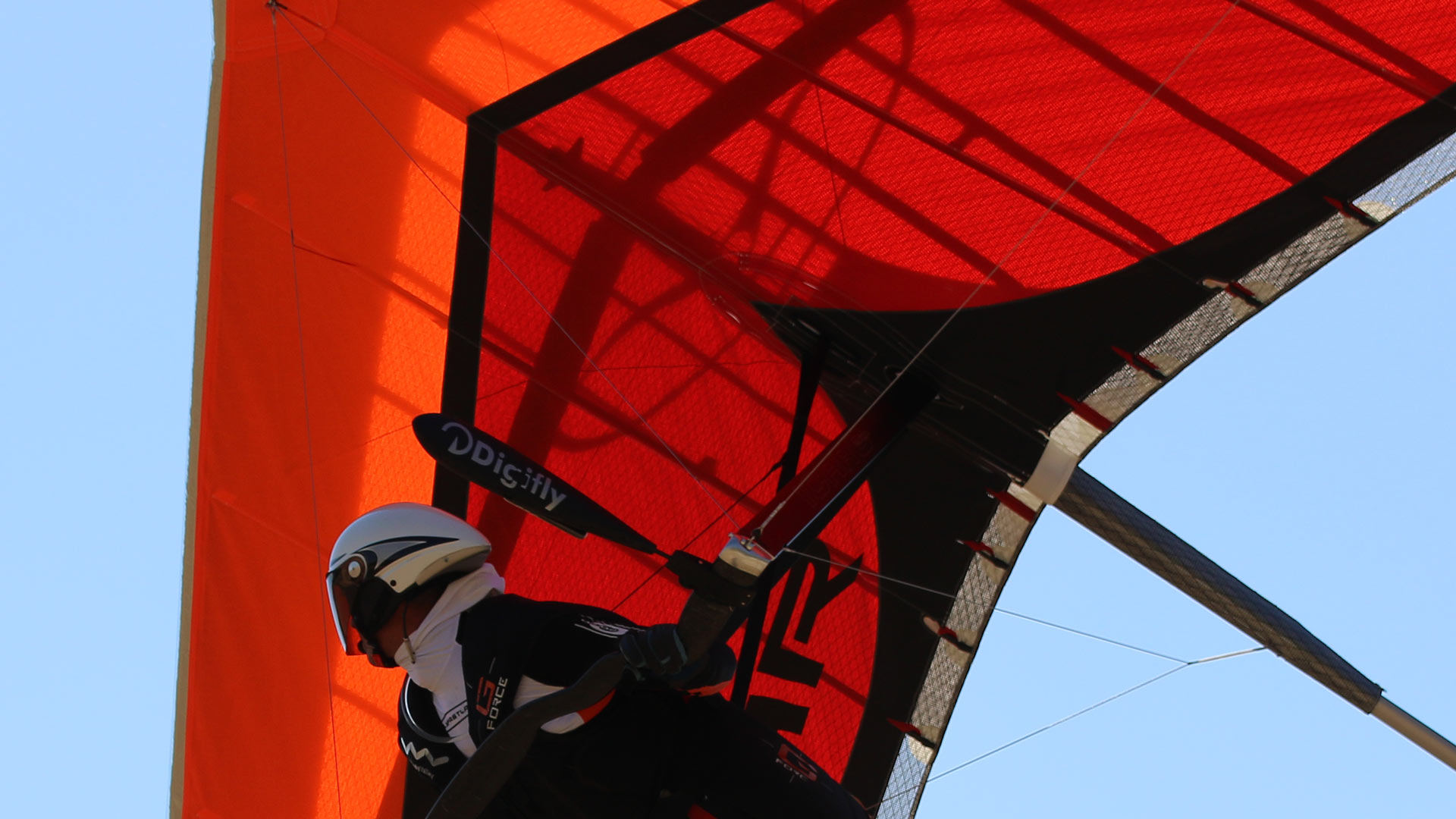
La voile Laminar est équipée de 6 mini-lattes amovibles sur le bord de fuite, d'un poids total inférieur à 15 grammes, qui ont permis d'éliminer les vibrations qui se produisaient parfois dans cette partie de la voile à des vitesses supérieures à 100 km/h.
Le bord d'attaque n'est pas interrompu au niveau du nez par la présence de poches pour les raidisseurs en Mylar, ce qui assure une distribution optimale et uniforme de la tension du bord d'attaque.
La nouvelle conception de l'extrados de la voile élimine totalement le moindre degré de déformation du tissu à tous les réglages de la VG pendant le vol.
Nous avons porté une attention particulière à l'amélioration de la tension de la voile dans la zone du bout d'aile, avec une nouvelle baguette de bout d'aile et une distribution différente de la tension afin d'obtenir une meilleure maniabilité.
Le design du bord d'attaque et la partie avant de la double surface ont été modifiés pour optimiser la forme du profil et la distribution de la tension.
De même, le dessin de la toile intérieure du bord d'attaque a également été modifié, toujours pour améliorer la tension de la voile dans la partie avant de l'aile.
Le rapport de corde entre la partie centrale et les extrémités de l'aile a été modifié, ce qui a permis d'augmenter le rapport d'aspect. Cela a apporté des avantages notables en termes de maniabilité, de performances, de stabilité et de plaisir de vol pour le pilote.
Les modèles 14.1 et 14.8 ont une latte supplémentaire pour réduire encore la déformation du profil à haute vitesse. Le rapport envergure/lattes est maintenant équivalent à celui des modèles plus petits.
Les poches à lattes sur l'intrados sont conçues pour empêcher les lattes de glisser lorsque le delta est exposé à un fort vent arrière pendant l'attente sur le site de décollage.
Le logement de la quille est maintenant doté d'un segment supplémentaire, un couvercle qui cache les poulies VG. Ce cache améliore l'aspect de la partie arrière de l'aile et réduit la traînée aérodynamique. Il offre une protection lorsque l'aile est démontée et fermée.
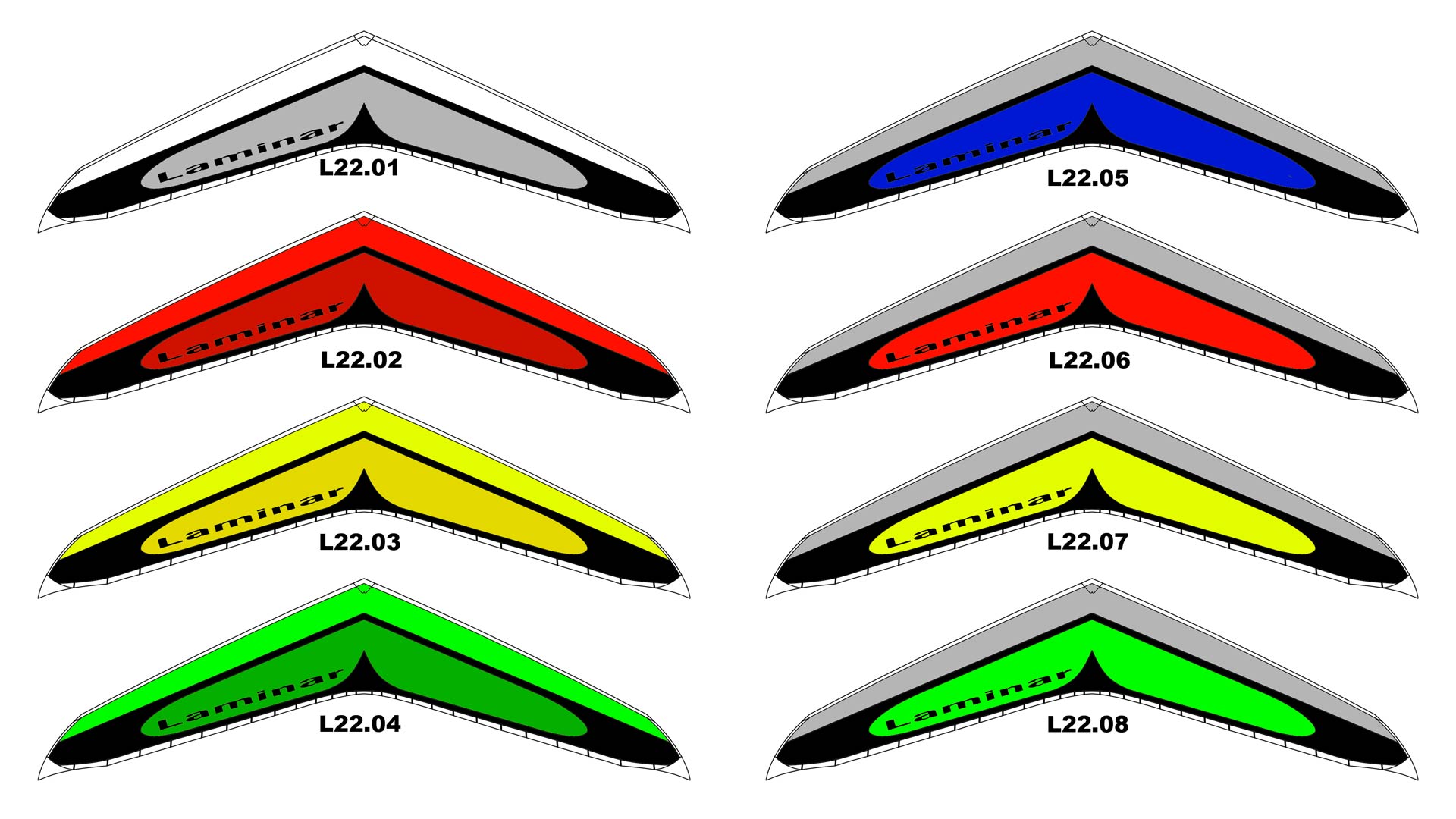
Il existe un choix de 8 couleurs standard différentes, mais un nombre infini de possibilités de personnalisation est disponible.
Le modèle standard est fourni avec notre voile spéciale en Dacron appelée "Square".
Cette voile offre la meilleure garantie de durabilité dans le temps. Elle possède d'excellentes caractéristiques de résistance à la déchirure grâce aux fibres de renforcement disposées dans deux directions orthogonales.
des fibres de renfort disposées dans deux directions orthogonales.
C'est le choix idéal pour les pilotes non compétiteurs qui souhaitent néanmoins voler avec un delta performant
qui garantit également une durée de vie opérationnelle prolongée.
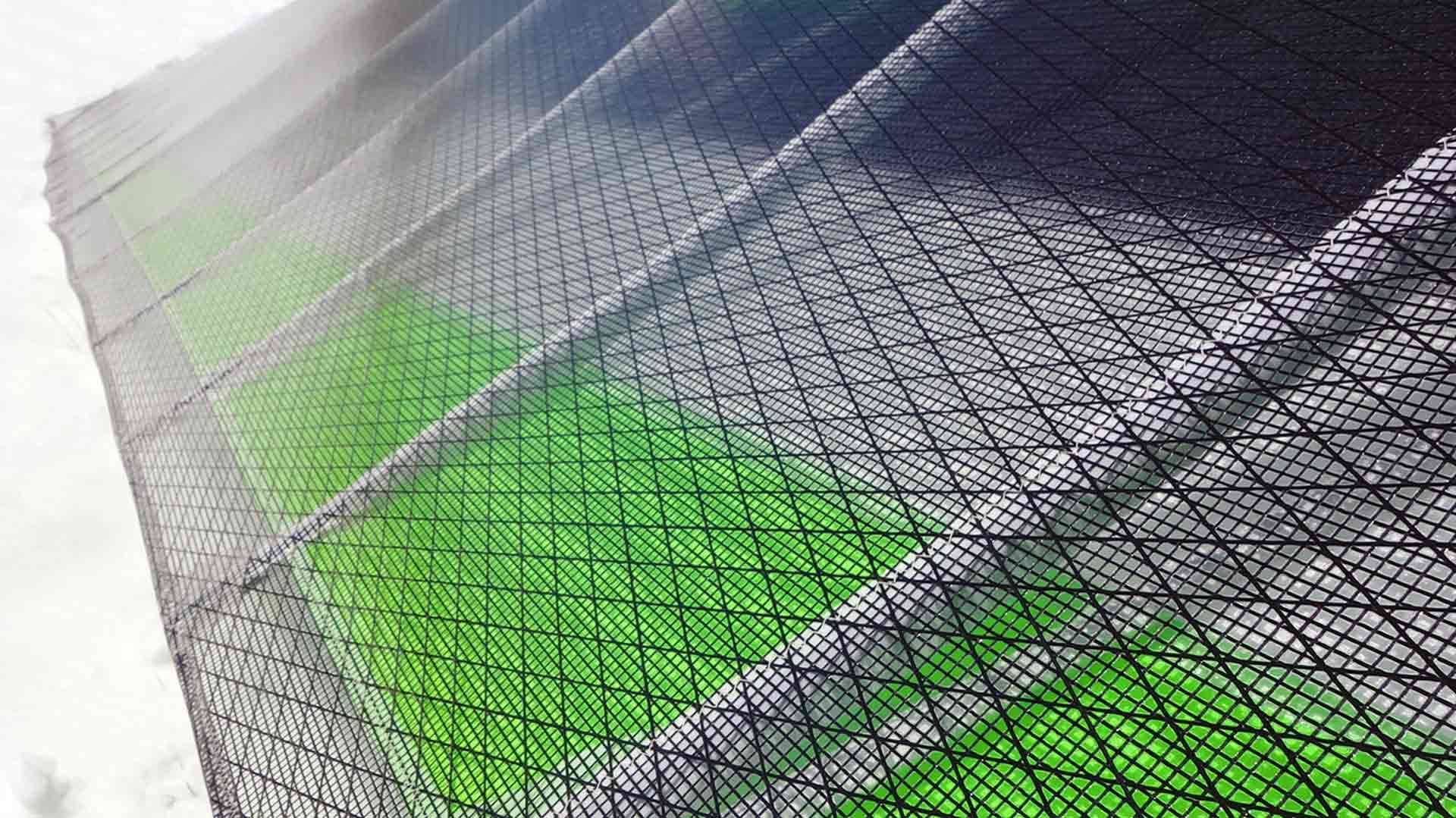
Icaro 2000 s'est engagé dans une recherche permanente de qualité et de performance optimales, et c'est pourquoi la voile LSP a été remplacée par une nouvelle voile en Technora.
La voile Technora pour la double surface offre un design encore plus fascinant, avec l'avantage supplémentaire de la réduction de poids offerte par ce tissu.
La voile complète en Technora est jusqu'à 700 grammes plus légère que la voile standard et possède des caractéristiques d'élongation beaucoup plus élevées. Elle confère à la Laminar une maniabilité encore meilleure, ainsi que des performances inégalées en vol plané.
L'expérience acquise lors des compétitions de voltige a conduit à un nouveau renforcement de la section centrale, spécialement conçu pour être utilisé avec les voiles Technora. Cela a rendu le parapente plus réactif et a amélioré l'efficacité de l'aile dans des manœuvres telles que la sortie brusque d'un piqué à grande vitesse.
Les renforts ajoutés aux extrémités des ailes sont également nouveaux, conçus pour augmenter la durabilité des voiles laminées tout en donnant aux deltaplanes de compétition un nouveau design plus agressif.
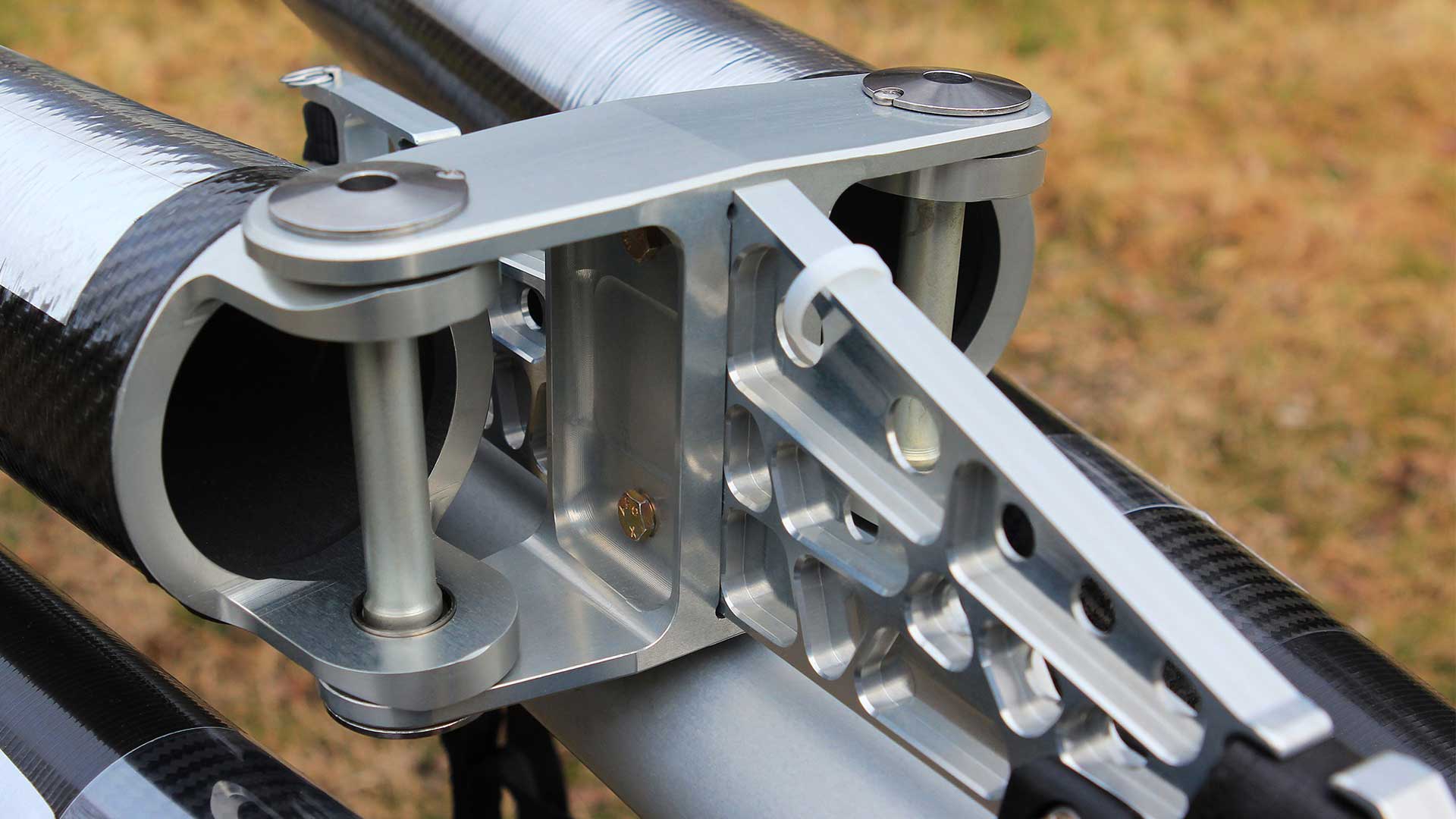
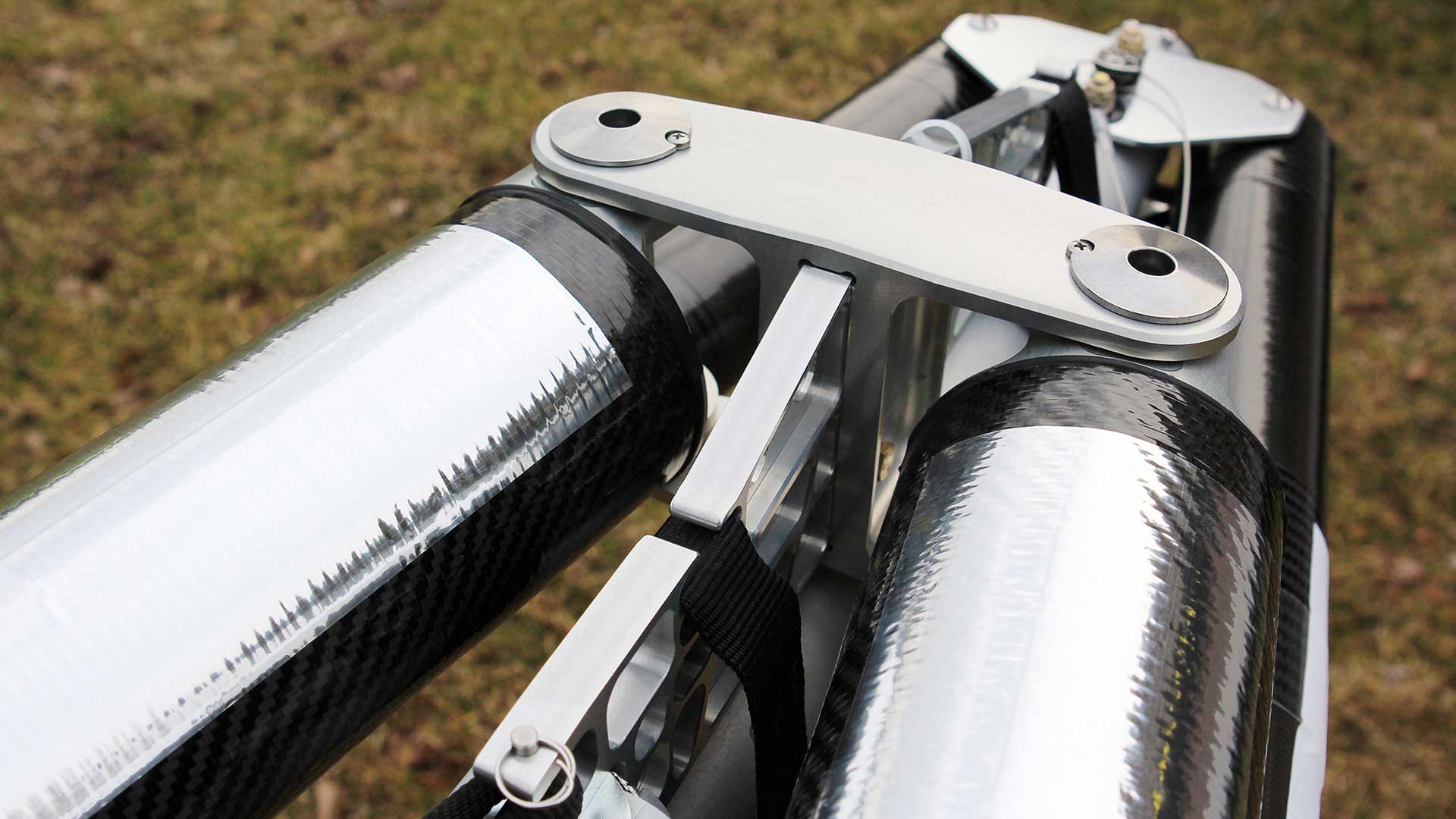
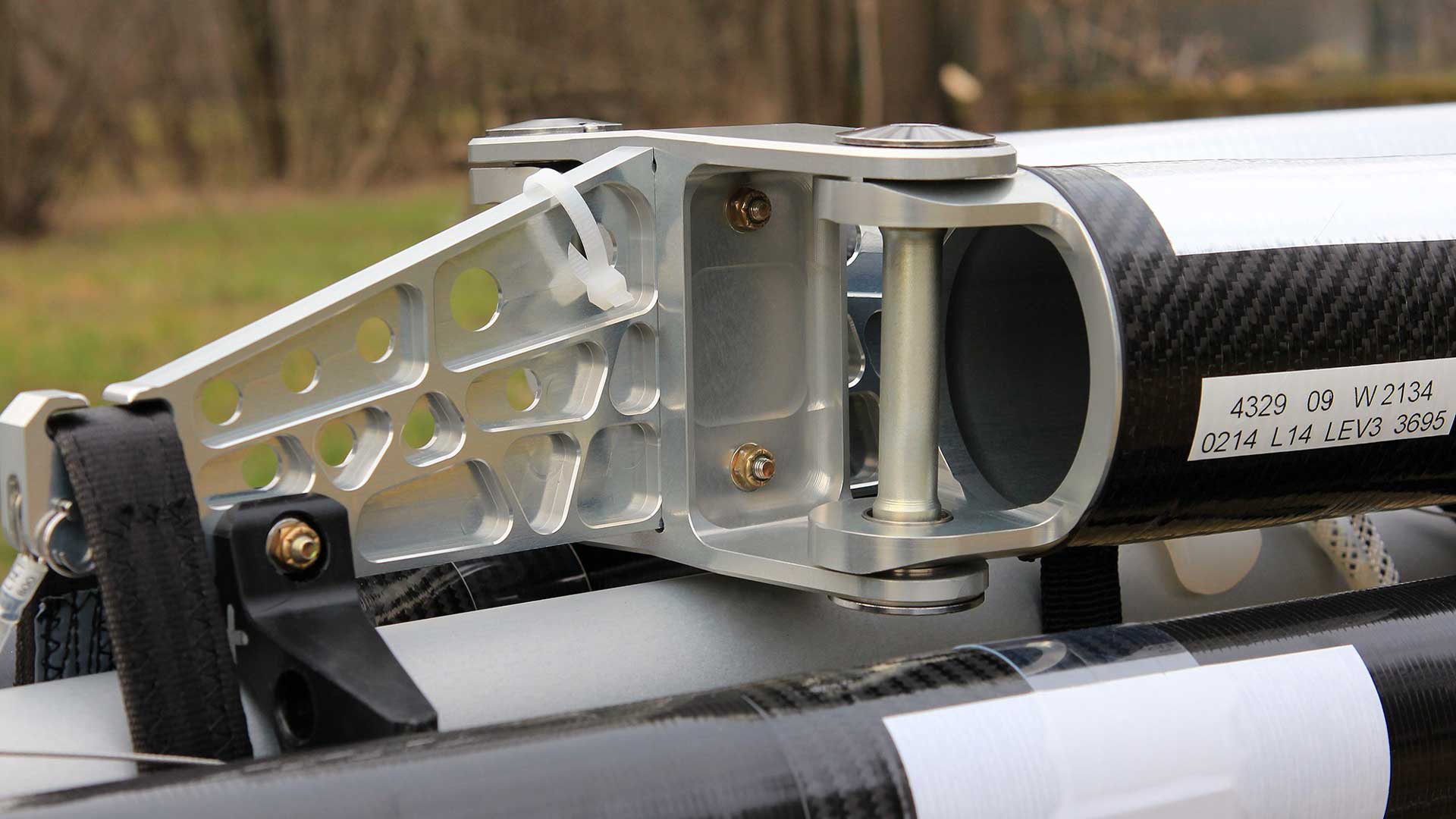
Les tubes utilisés pour les deltaplanes Icaro 2000 sont fabriqués en Ergal 7075, l'alliage utilisé dans l'industrie aérospatiale.
Ils sont fabriqués par emboutissage, ce qui garantit les meilleures performances possibles en termes de poids, de rigidité et de fiabilité.
poids, de rigidité et de fiabilité.
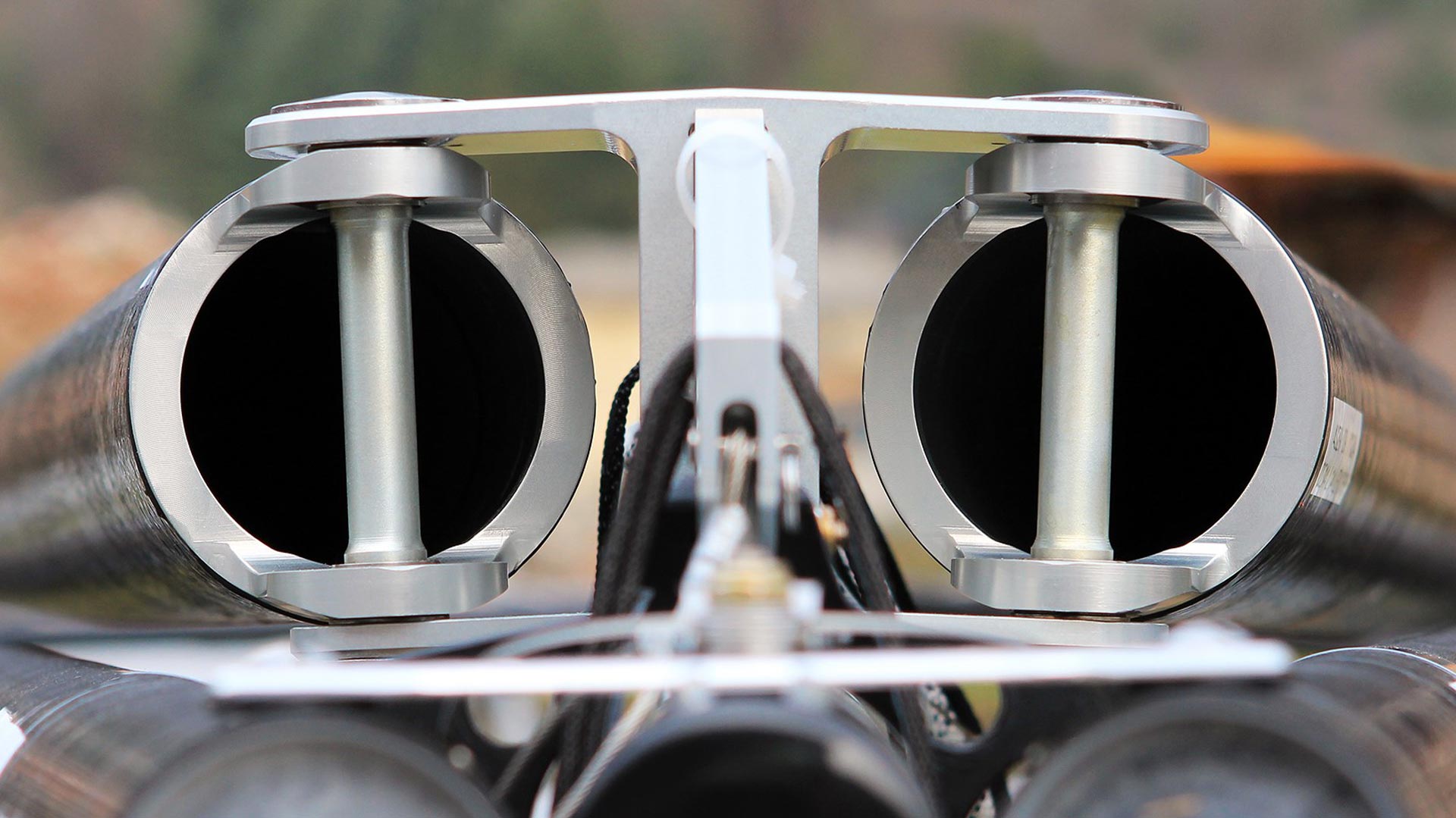
Le nouveau design de la barre transversale, avec un diamètre et une section circulaire accrus, et la nouvelle stratification
du carbone utilisé dans ce composant, ont permis une réduction considérable du poids, tout en augmentant la charge maximale au décollage.
Un nouveau H-block central plus robuste a permis d'atteindre ces résultats.
Les nouvelles articulations entre la barre transversale et le longeron de l'aile ont également contribué à la réduction du poids, en améliorant le transfert de charge vers la barre transversale et en augmentant la rigidité en torsion.
Grâce à ces innovations, le gain de poids total par rapport à la version légère précédente de la barre transversale est de 700 grammes dans la taille 14.1 et de 1 200 grammes dans la taille 12.6.
la taille 12.6. Dans le même temps, le poids maximum autorisé au décollage a augmenté de 10 kg dans la plus grande taille du delta.
Icaro2000 est le seul fabricant de deltaplanes au monde à fabriquer, pour tous ses modèles topless, un bloc de jonction de la barre transversale centrale en Ergal 7075, réalisé par usinage à commande numérique d'un bloc massif.
Ce procédé permet d'obtenir un composant solide et léger, dans lequel les contraintes sont uniformément réparties sur l'ensemble de la structure.
uniformément dans toute la structure de l'unité.
Le coût de ce procédé technologique, comparé au système habituel utilisé par nos concurrents (deux plaques d'aluminium vissées à la glissière centrale), est beaucoup plus élevé.
En revanche, il garantit un degré plus élevé de résistance et de fiabilité.
Le nouveau bloc en H a été redessiné afin d'accueillir la barre transversale à section circulaire de dimensions accrues. La plus grande résistance ainsi obtenue a permis d'atteindre les augmentations de masse maximale au décollage décrites ci-dessus.
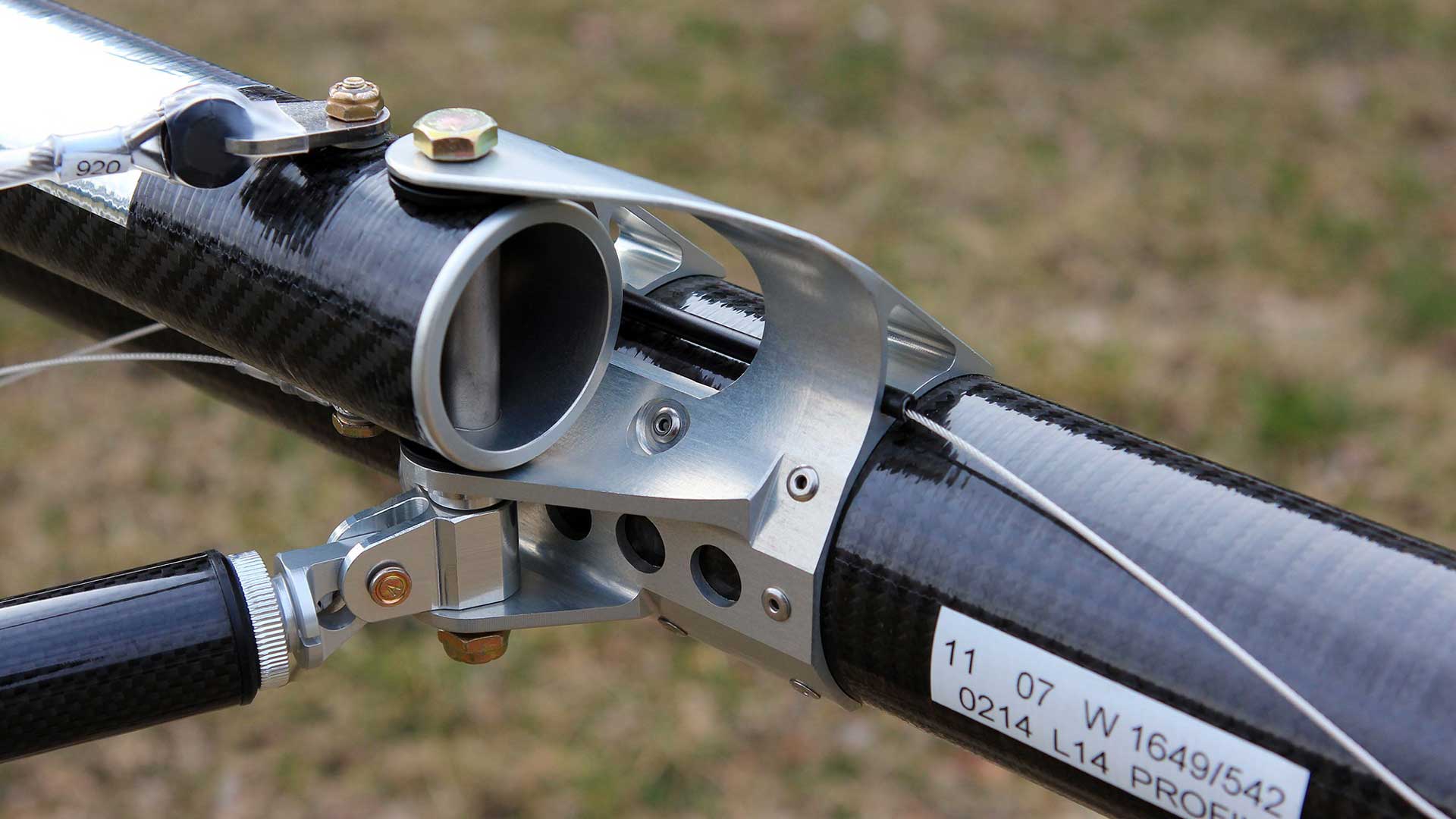
Les nouvelles articulations entre la barre transversale et le longeron ont permis de réduire le poids total et, surtout, d'améliorer la répartition des contraintes sur l'ensemble de la barre transversale, tout en augmentant la rigidité en torsion de l'articulation entre la barre transversale et le longeron.
Cela a permis d'atteindre le niveau de stabilité souhaité pour le delta, avec des valeurs de sprog inférieures à celles du Z9.
Quant à la jonction centrale de la barre transversale, ce composant important en Ergal 7075 est fabriqué par l'usinage à commande numérique d'une plaque de verre.
l'usinage à commande numérique d'un bloc massif.
L'unité résultante est résistante et compacte, contribuant à donner au planeur un profil d'aile optimal dans toutes les configurations VG.
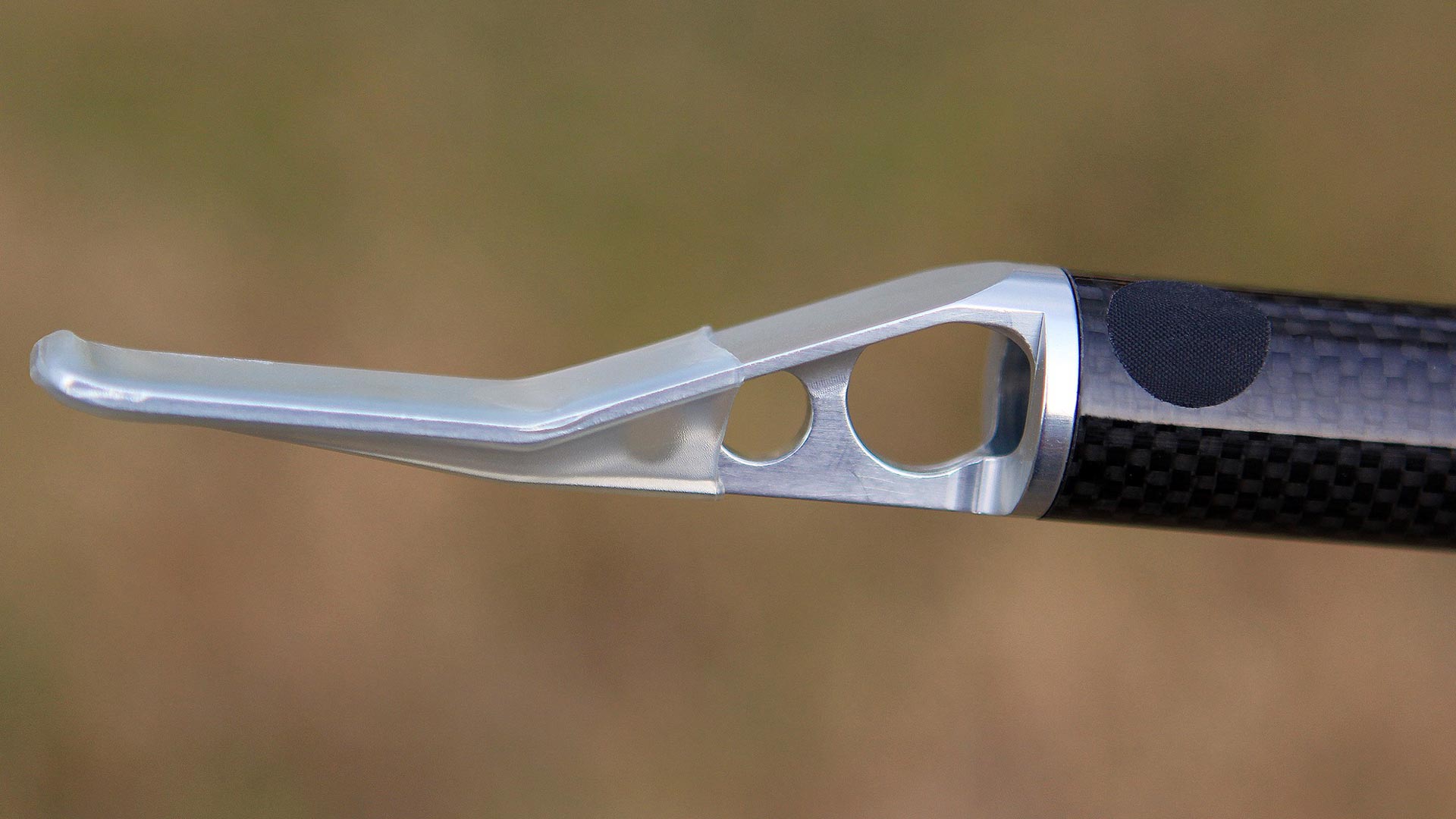
Le sprog en carbone de la section centrale de chaque demi-aile a été légèrement compensé afin d'obtenir une dérive variable selon les différentes configurations du VG.
Il est plus grand sur la Laminar, ce qui lui confère une plus grande résistance et rend la surface de l'aile plus propre, grâce à une pièce usinée à partir d'un morceau d'Ergal solide à l'extrémité du sprog.
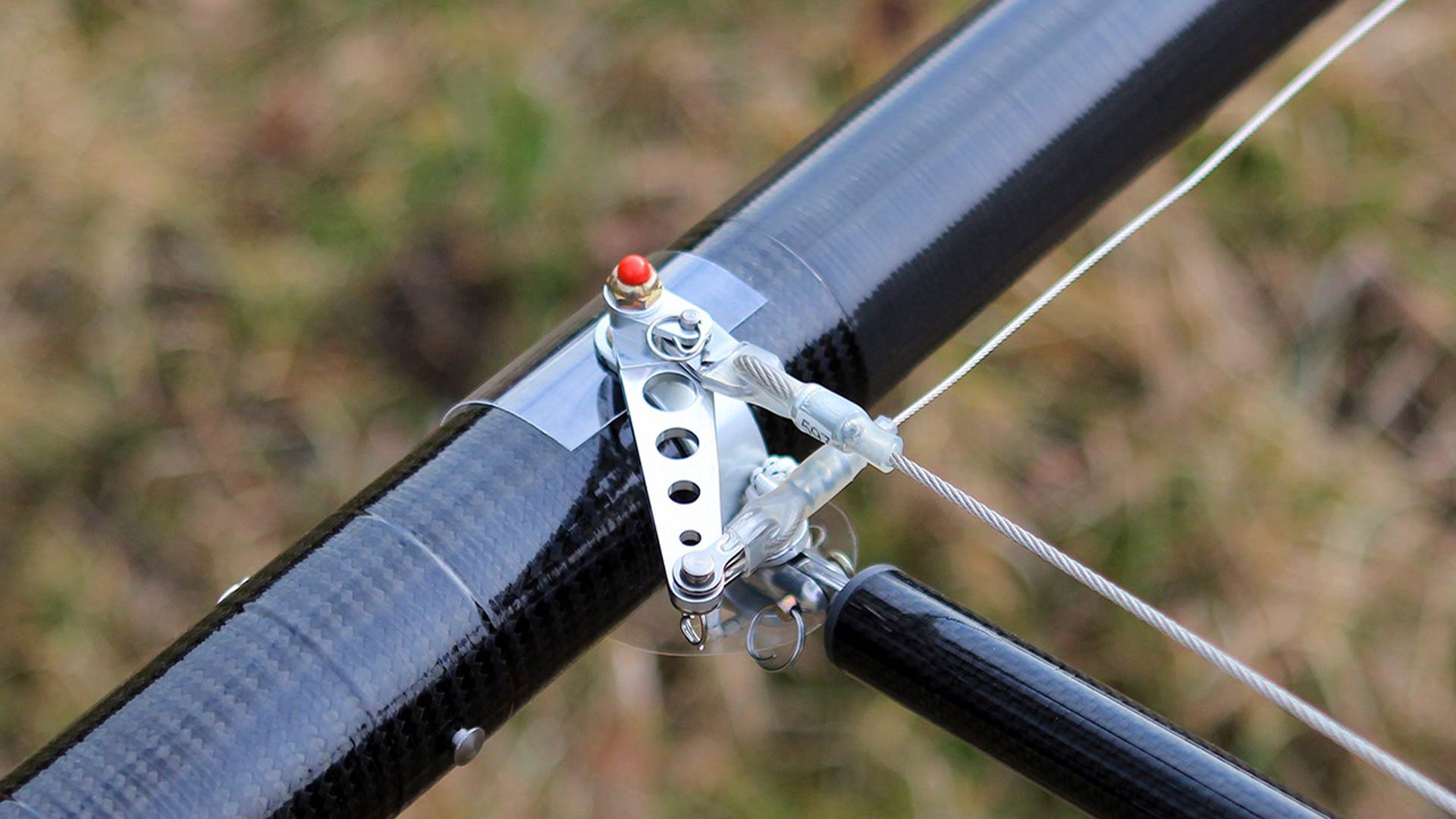
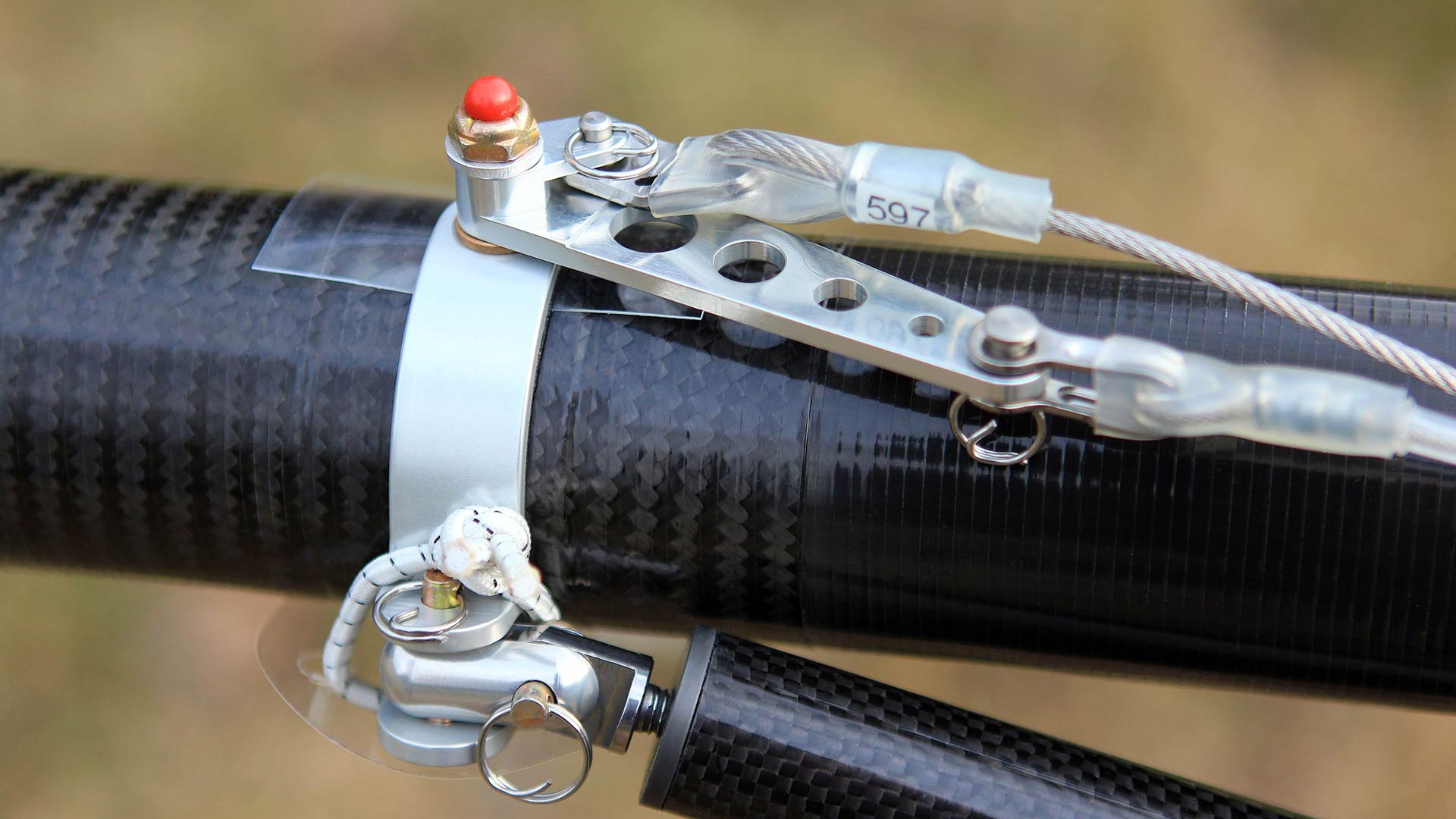
Les nouveaux bouts en fibre de carbone sont plus épais et ont une partie en Ergal à leur extrémité, comme les sprogs.
Ils sont fabriqués avec le système exclusif Icaro 2000 "Compensated Twist Tips", qui garantit que les bouts extérieurs (qui fournissent un support aux deux lattes les plus extérieures) peuvent se déplacer dans des directions mutuellement opposées, même lorsque la voile est en contact direct avec eux.
Cette situation se produit dans les configurations à géométrie variable de ½ à plein.
Dans ces configurations VG, les ailes de la génération précédente ne permettaient aucun mouvement de la voile, ce qui entraînait une réduction des qualités de maniabilité.
Le système est complété par un système de compensation efficace, une autre exclusivité d'Icaro 2000, lié au mouvement de la VG, garantissant les meilleures performances et la meilleure stabilité possibles pour l'aile delta.
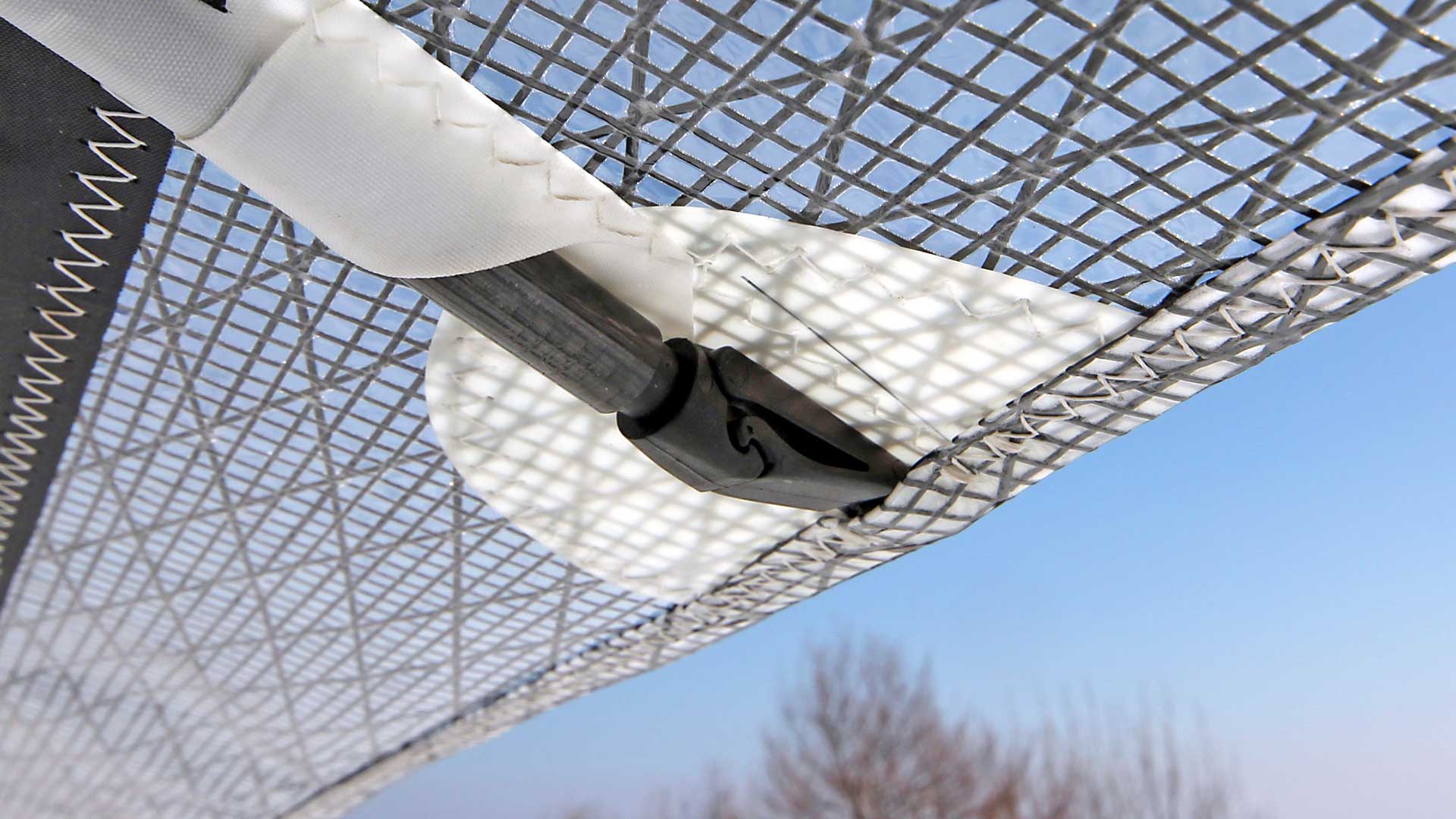
Le système "snap lock" est efficace et pratique, et permet également de régler avec précision la tension de la voile.
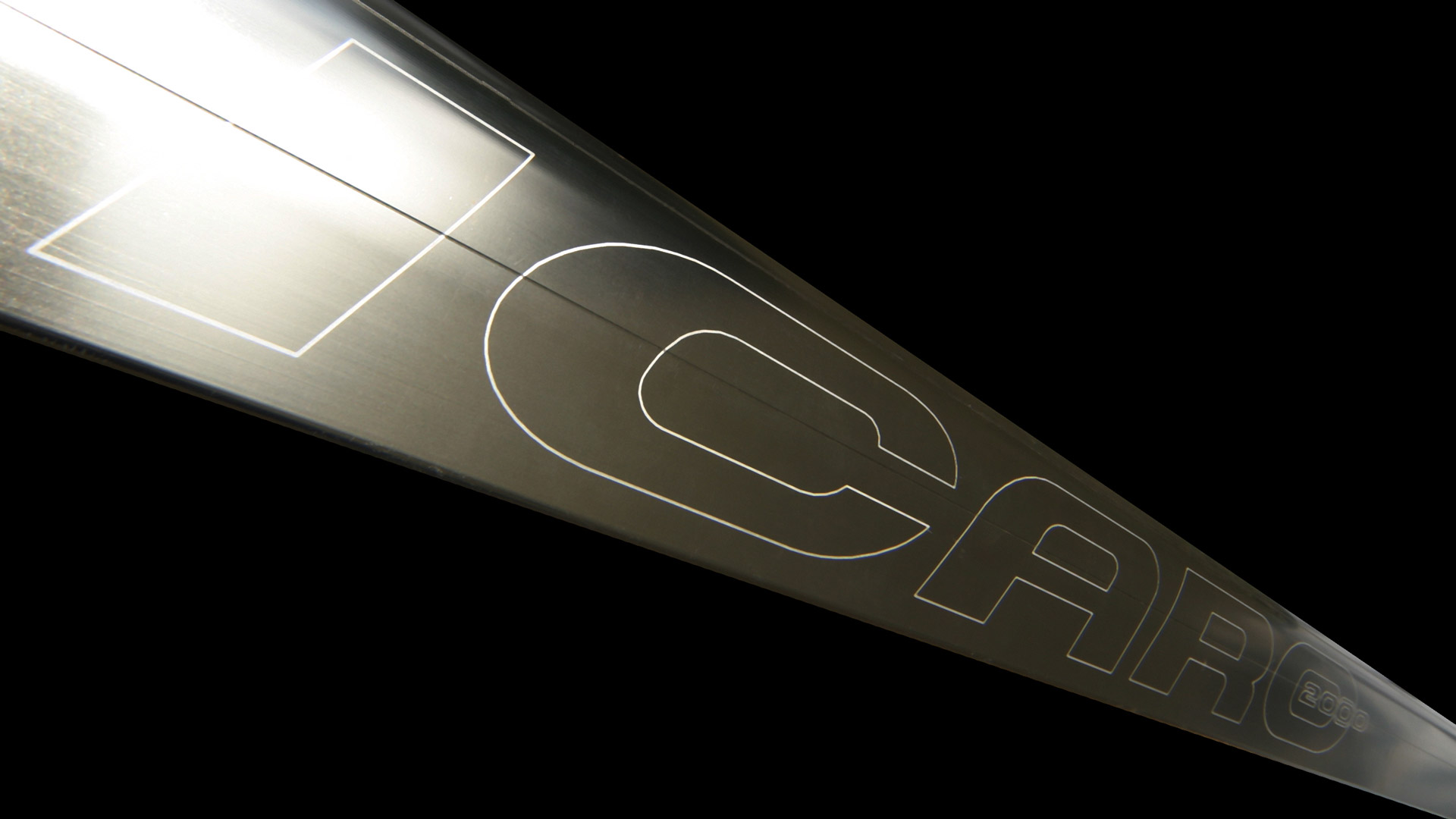
Les tubes inférieurs de compétition en aluminium ont un profil qui inclut un turbulateur, ce qui garantit un faible coefficient de traînée aérodynamique et assure le meilleur rapport performance/prix possible.
Comme ils sont légèrement plus longs que les tubes inférieurs standard, ils confèrent également à l'aile une meilleure maniabilité et éliminent tout biais dans les virages.
Ce cadre A est disponible avec l'accélérateur MR en fibre de carbone.
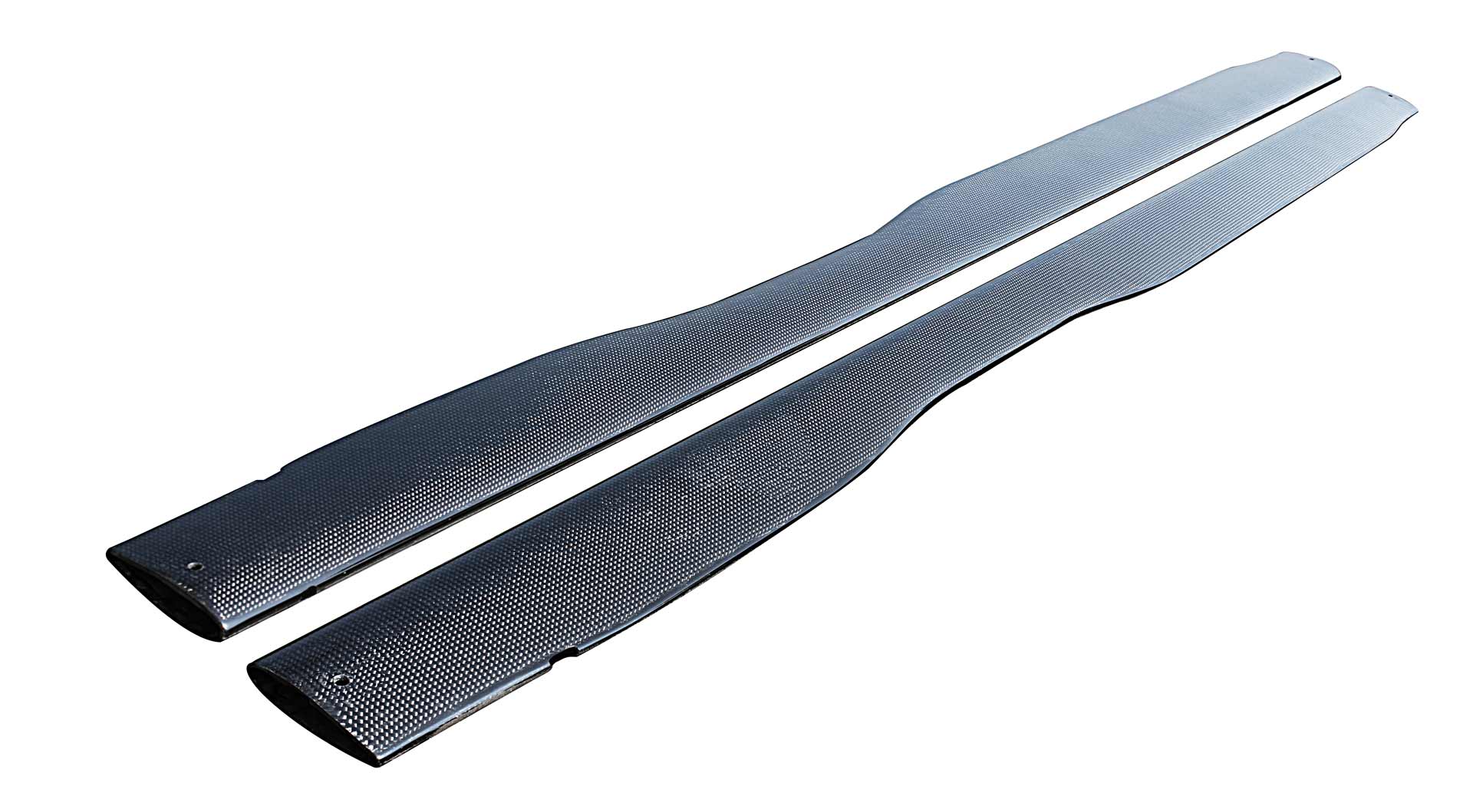
Les tubes inférieurs de compétition en aluminium ont un profil qui inclut un turbulateur, ce qui garantit un faible coefficient de traînée aérodynamique et assure le meilleur rapport performance/prix possible.
Comme ils sont légèrement plus longs que les tubes inférieurs standard, ils confèrent également à l'aile une meilleure maniabilité et éliminent tout biais dans les virages.
Ce cadre A est disponible avec l'accélérateur MR en fibre de carbone.
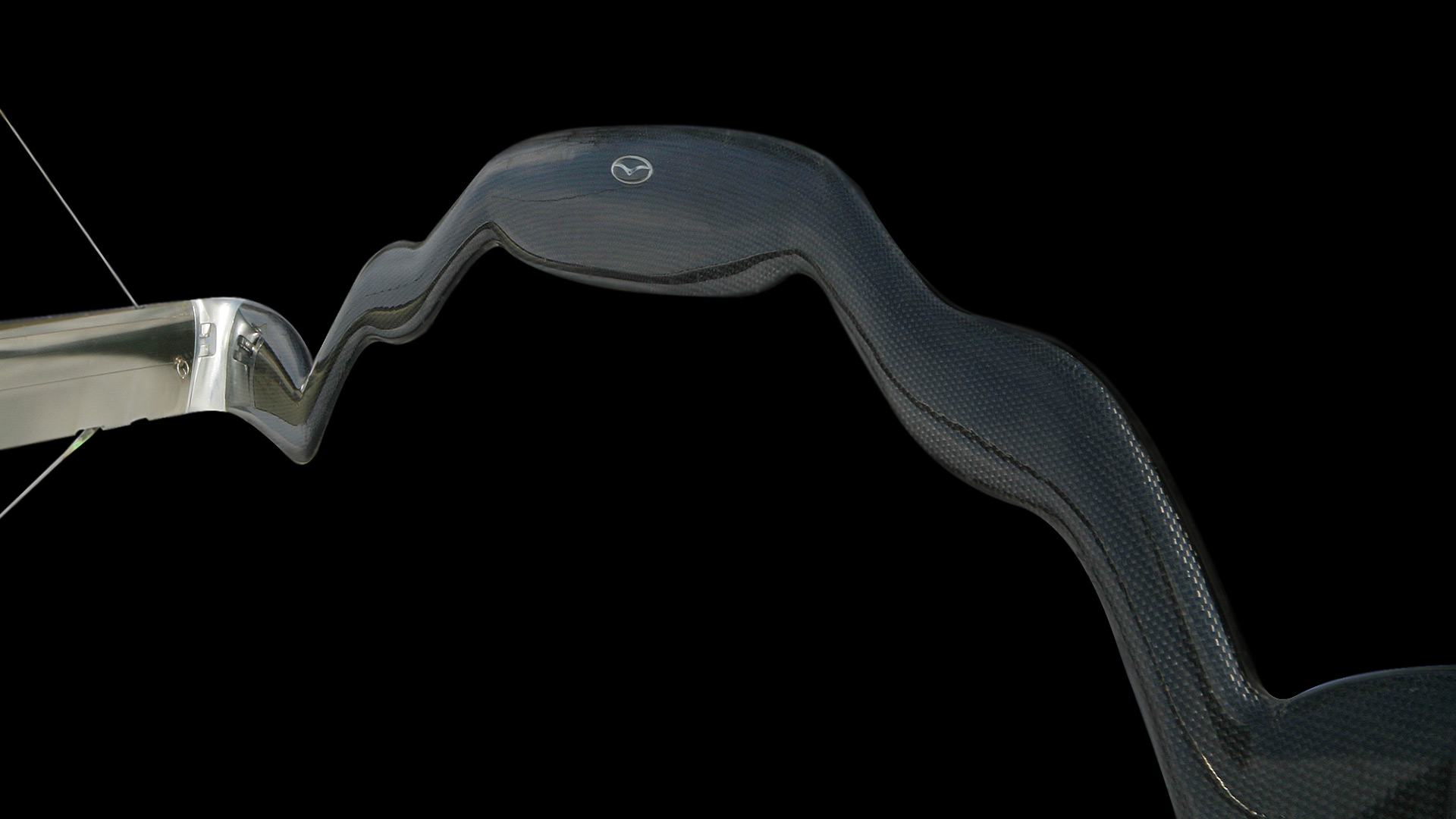
Aérodynamisme, ergonomie, légèreté. Dans vos mains.
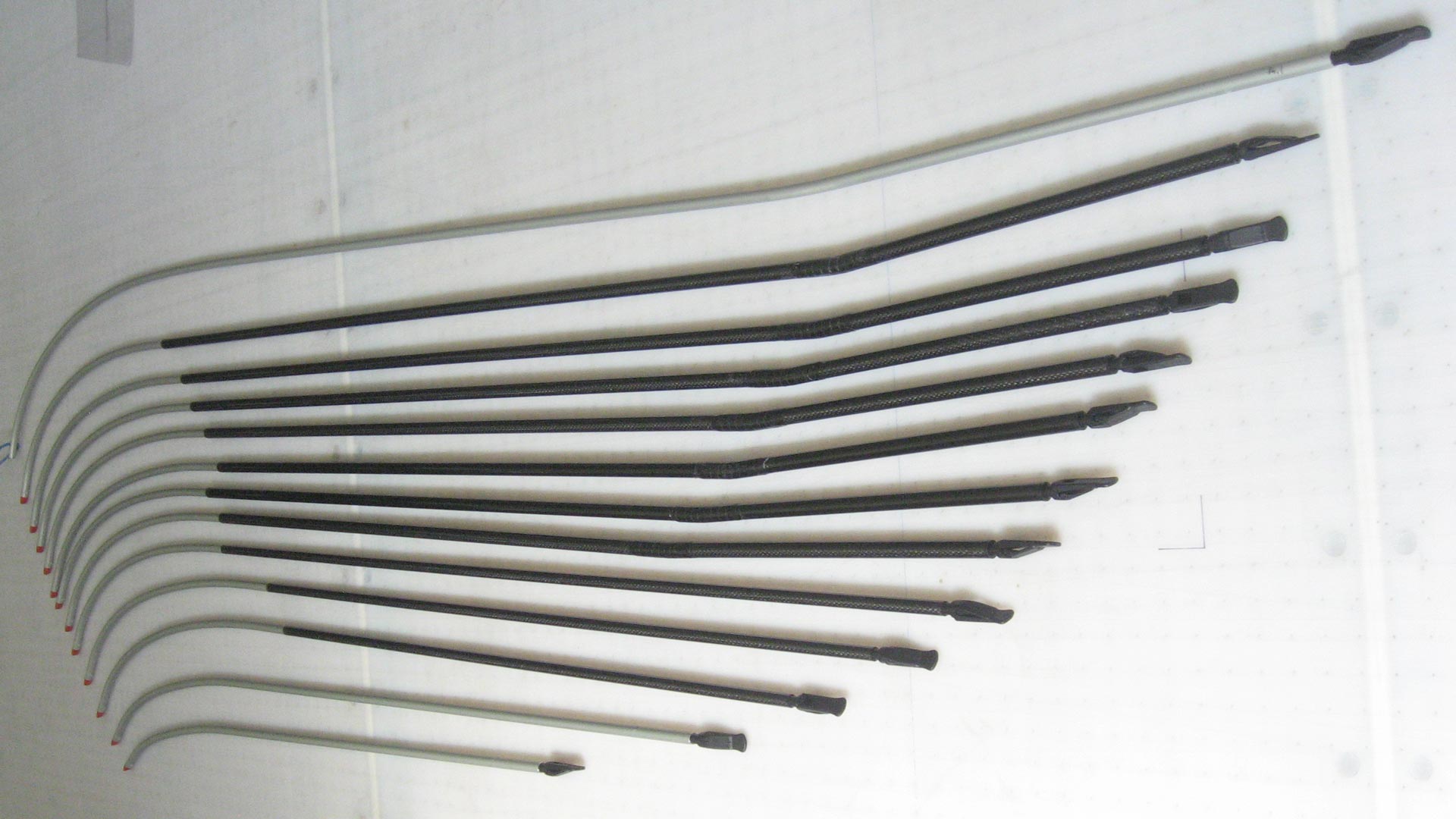
Les lattes en carbone ont une rigidité bien supérieure à celle des lattes en aluminium, ce qui confère au deltaplane une plus grande stabilité et de meilleures performances.
Les avantages des lattes en fibre de carbone sont immédiatement évidents du fait de la plus grande stabilité qu'elles procurent.
Le profil de l'aile reflex est en effet amélioré par la plus grande rigidité de ce type de lattes, ce qui a un effet important sur la stabilité de l'aile. En conséquence, le degré de dérive introduit par les sprogs et les bouts d'aile peut être réduit.
L'efficacité des lattes en carbone est telle qu'elles devraient être la première option à choisir lorsque l'objectif est de posséder un delta le plus performant possible.
Par exemple, en utilisant des lattes en aluminium, avec la VG complètement serrée et les sprogs et les bouts ajustés au maximum, la pression en barre est proche de zéro à environ 90 km/h. En pilotant le même delta dans la même configuration, mais avec les nouvelles lattes en fibre de carbone, la pression en barre sera positive à toutes les vitesses ; plus précisément, elle sera légère, mais toujours positive, même à 120 km/h.
Nos lattes en carbone ont un diamètre de 12 et 10 mm.
Les avantages que nous avons tirés de l'utilisation des lattes en carbone sont si exceptionnels que leur adoption est plus que justifiée, malgré leur prix élevé.
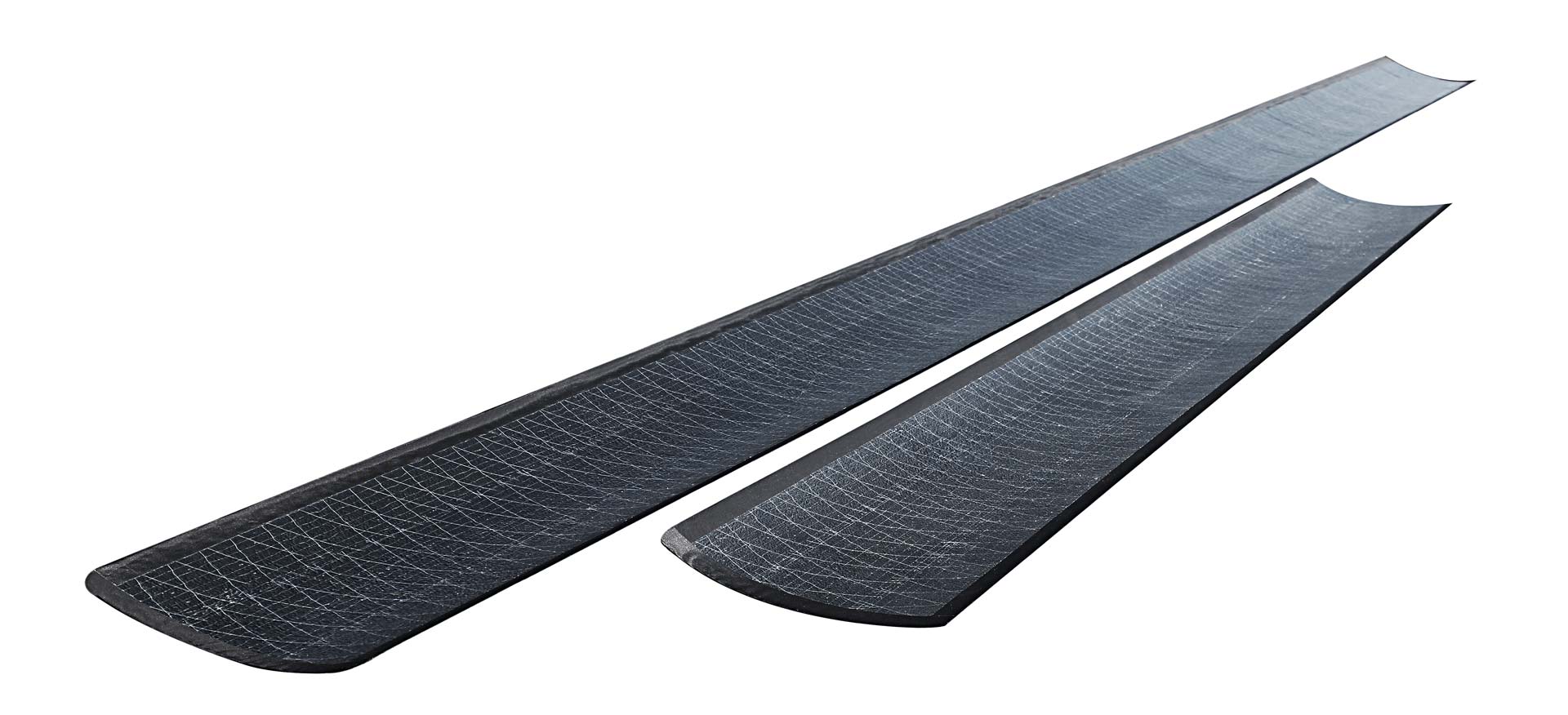
Ces composants en fibre de carbone sont insérés dans une poche en Mylar située dans la partie centrale du bord d'attaque. Ils sont disponibles en deux longueurs, 1,25 et 2,5 m, toutes deux d'une largeur de 20 cm.
Ce composant optionnel empêche les changements de profil de la voilure à grande vitesse, optimisant ainsi les performances à des vitesses supérieures à 80 km/h.
Nous recommandons la version de 2,5 m uniquement à ceux qui ne veulent pas se priver du léger avantage en vol plané, même si cela représente un sacrifice d'environ 300 grammes.
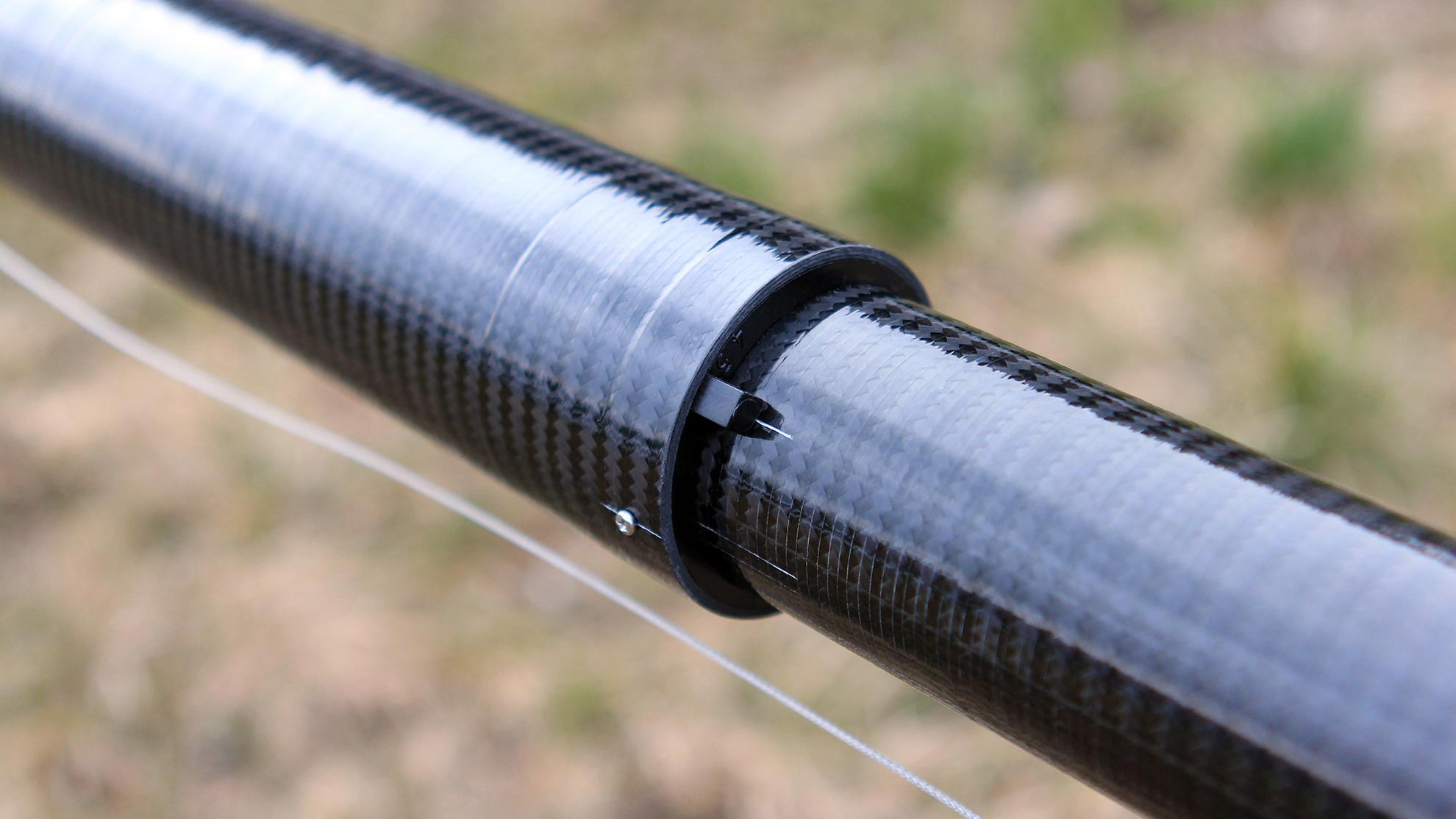
Conçus pour optimiser la maniabilité et les performances, les bords d'attaque en carbone permettent de réduire le poids jusqu'à 1,25 kg et d'augmenter la rigidité de 10 %.
Dans la configuration avec la partie avant du bord d'attaque en aluminium et l'extrémité en carbone, la réduction de poids est d'environ 550 grammes, dans la zone où le facteur poids est le plus important.
Ils ont une épaisseur minimale de 30 % supérieure à celle de la version en aluminium et sont également plus résistants, ce qui garantit une fiabilité et une durabilité élevées.
La combinaison parfaite de performance et de maniabilité.

Développés pour réduire les tourbillons en bout d'aile, les nouveaux bouts d'aile augmentent l'allongement et donc les performances dans la plage des vitesses moyennes et basses.
En conséquence, ils améliorent l'efficacité aux vitesses de vol à voile les plus fréquemment utilisées et augmentent les performances en thermique.
En même temps, ils donnent un nouveau look attrayant au delta.
Le Profiler est une mousse appliquée à l'avant du tube de longeron du bord d'attaque, réduisant son rayon de courbure et lui donnant une plus grande pénétration.
Il a également pour effet secondaire d'augmenter la tension de la voile et de réduire la dérive lorsque la VG est à plein régime, ce qui augmente les performances à grande vitesse.
Il augmente donc les performances à haute vitesse.
Icaro 2000 recommande de respecter l'échéancier de l'entretien programmé tel qu'il est détaillé dans le manuel d'utilisation. En outre, le fabricant rappelle qu'un contrôle supplémentaire peut être nécessaire chaque fois qu'un événement inhabituel (atterrissage brutal, conditions de transport inadaptées, etc.) met en doute la navigabilité de l'aile. L'entretien et les contrôles programmés doivent être effectués uniquement par du personnel qualifié, en utilisant exclusivement des pièces de rechange d'origine Icaro 2000.
A cet égard, Icaro 2000 peut effectuer les opérations d'entretien d'un delta en l'espace d'une journée, sur rendez-vous.
Icaro 2000 rappelle également que les voiles de deltaplane doivent être remplacées périodiquement. Au fil des ans, les pliages répétés et l'exposition au soleil provoquent une détérioration progressive de la résistance physique et de la forme, ce qui affecte les paramètres de charge maximale admissible, le comportement aérodynamique de l'aile et donc la stabilité du delta. Ce processus de vieillissement affecte tous les types de voile, bien qu'à des degrés différents.